
For other people named Thomas Sopwith, see Thomas Sopwith (disambiguation).
Sir Thomas Octave Murdoch Sopwith, CBE, Hon FRAeS (January 18, 1888–January 27, 1989) was an English aviation pioneer as well as a celebrated yachtsman.
Thomas Octave Murdoch Sopwith was born in Kensington, London. He was the eighth child and only son of a civil engineer. He was educated at Cottesmore School in Hove and at Seafield Park engineering college in Lee-on-Solent.
In his youth, he was an expert ice skater and played in goal during Princes Ice Hockey Club's 1908 match with C. P. P. Paris.
He became interested in flying after seeing John Moisant flying the first cross-Channel passenger flight. His first flight was with Gustave Blondeau in a Farman at Brooklands. He soon taught himself to fly on a British Avis monoplane and took to the air on his own for the first time on October 22, 1910. Unfortunately he crashed after travelling about 300 yards (275 metres). He soon improved and on November 22 was awarded Royal Aero Club Aviation Certificate No. 31.
On December 18, 1910, Sopwith won a £4,000 prize for the longest flight from England to the Continent in a British built aeroplane. He flew 169 miles (272 km) in 3 hours 40 minutes. He used the winnings to set up the Sopwith School of Flying at Brooklands.
In June 1912 Sopwith with Fred Sigrist and others set up The Sopwith Aviation Company. The company produced key British World War I aircraft, most famously the Sopwith Camel. Sopwith was awarded the CBE in 1918.
Bankrupted after the war by the punitive anti-profiteering taxes, he re-entered the business a few years later with a new firm named after his chief engineer and test pilot, Harry Hawker. Sopwith was chairman of the new firm, Hawker Aircraft.
In 1934 and 1937, Sopwith led challenges for the America's Cup in his yachts Endeavour and Endeavour II. Both yachts featured advanced technology. In addition to owning the yachts and organising the challenges, Sopwith was also helmsman during the races.
He was knighted in 1953.
After the nationalization of what was by then Hawker Siddeley, he continued to work as a consultant as late as 1980. His 100th birthday was marked by a flypast of military aircraft over his home. He died in Hampshire on January 27, 1989, aged 101.
His authorized biography is Pure Luck by Alan Bramson, with a foreword by the Prince of Wales (ISBN 1-85260-263-5).
No comments:
Post a Comment